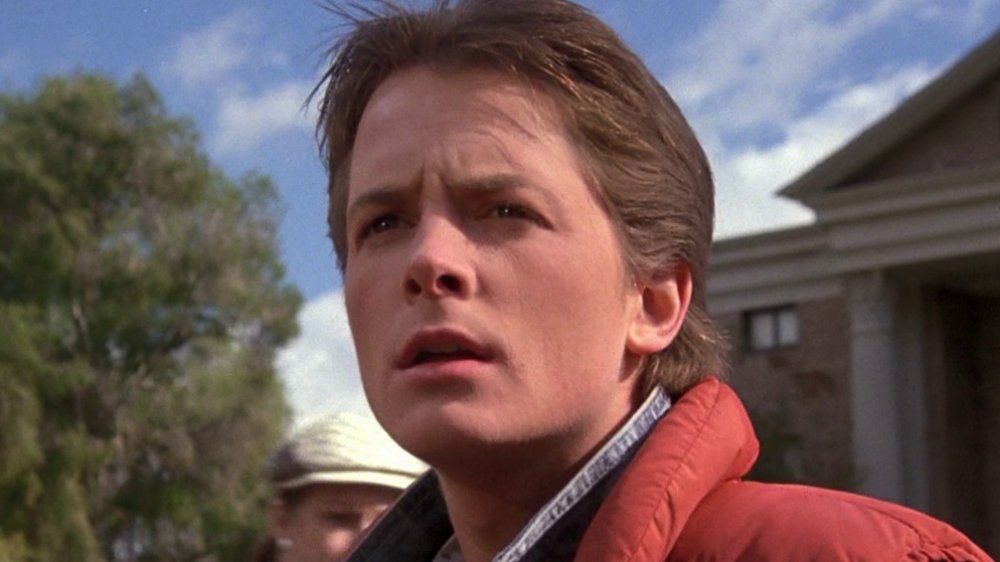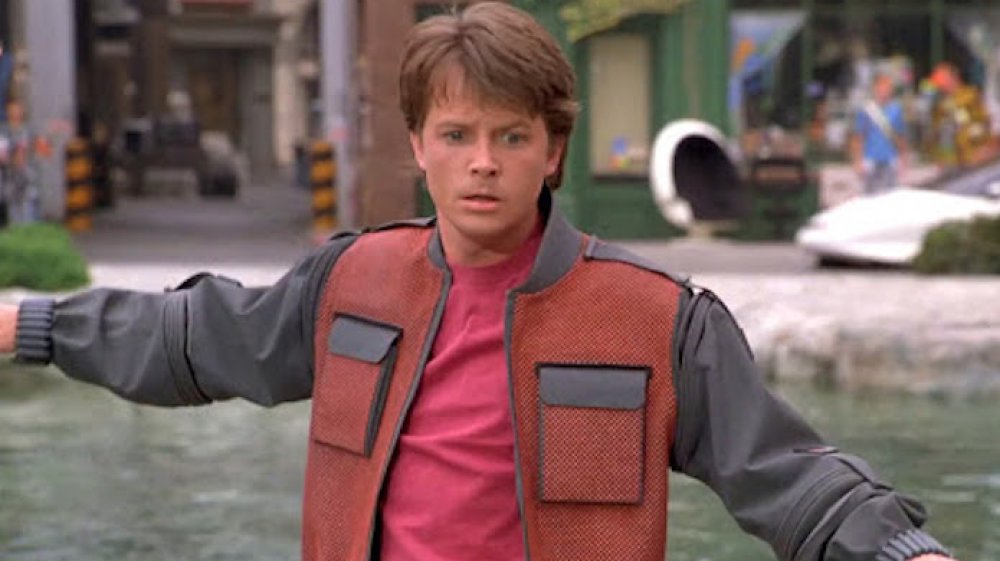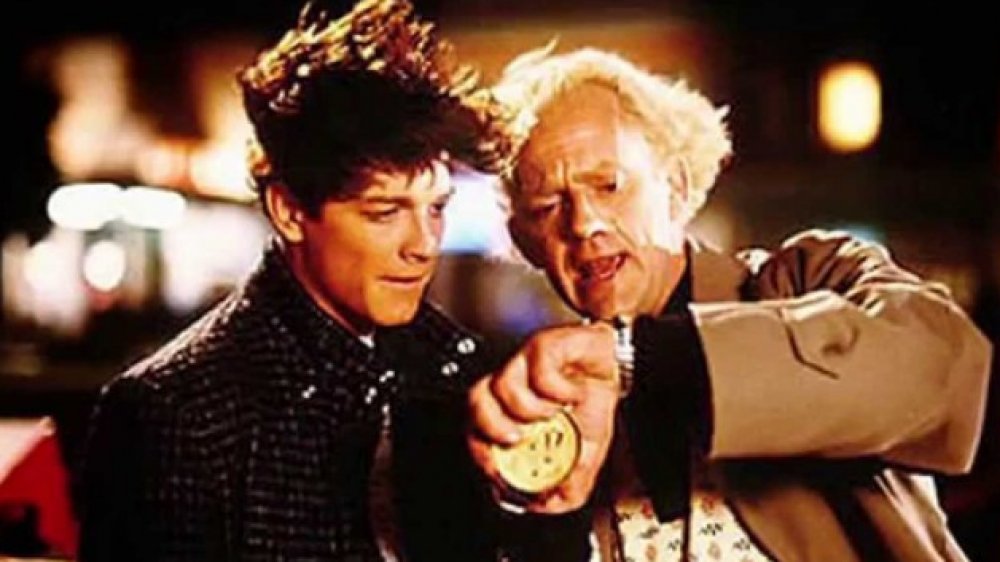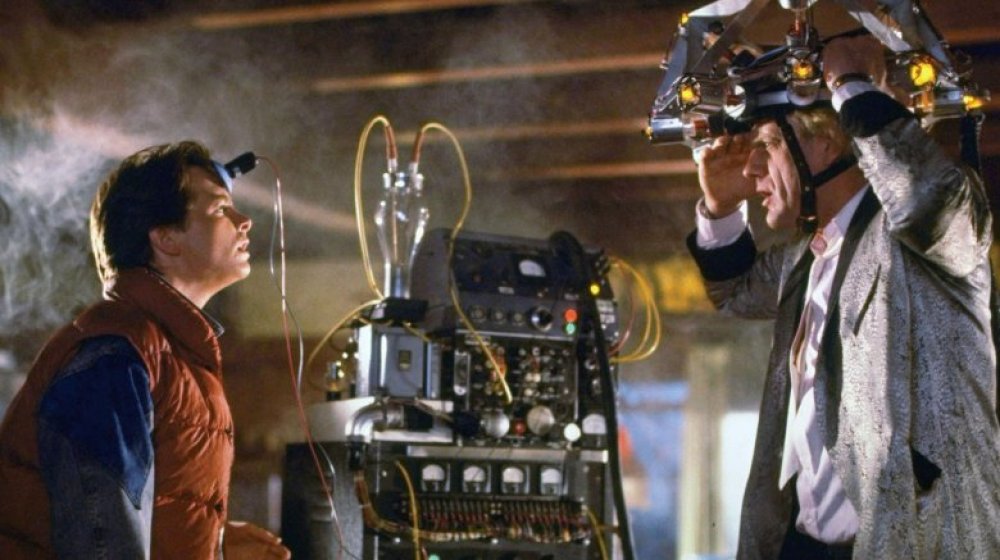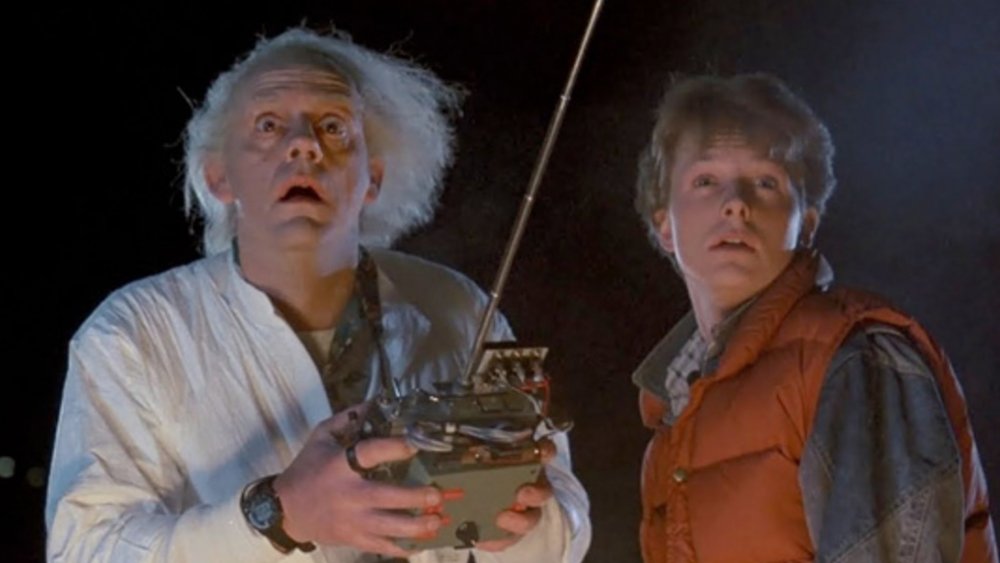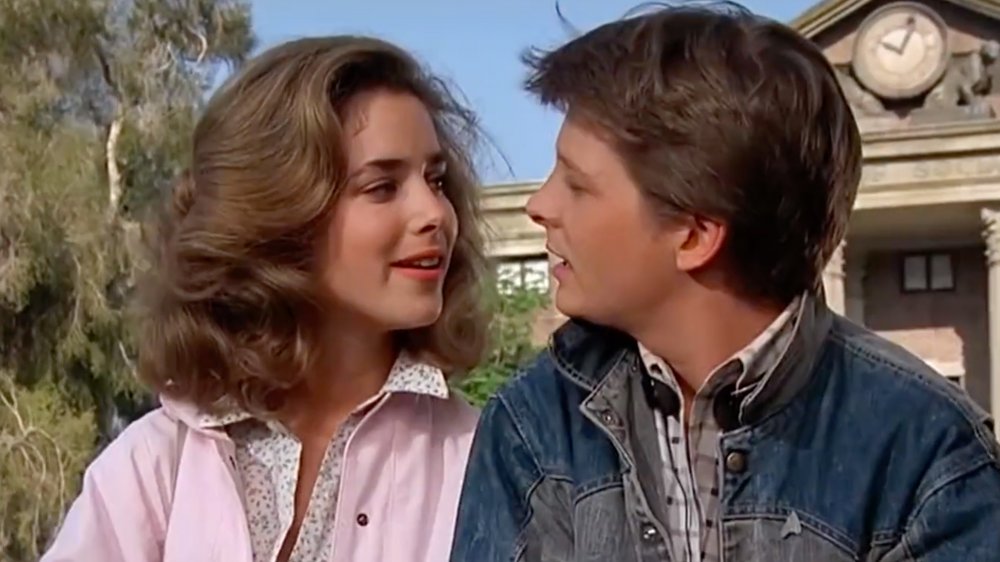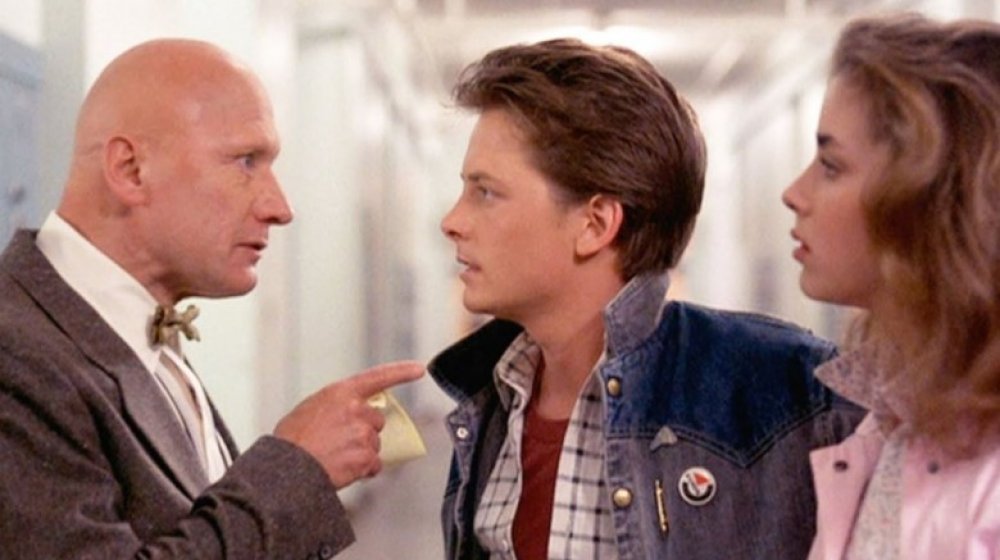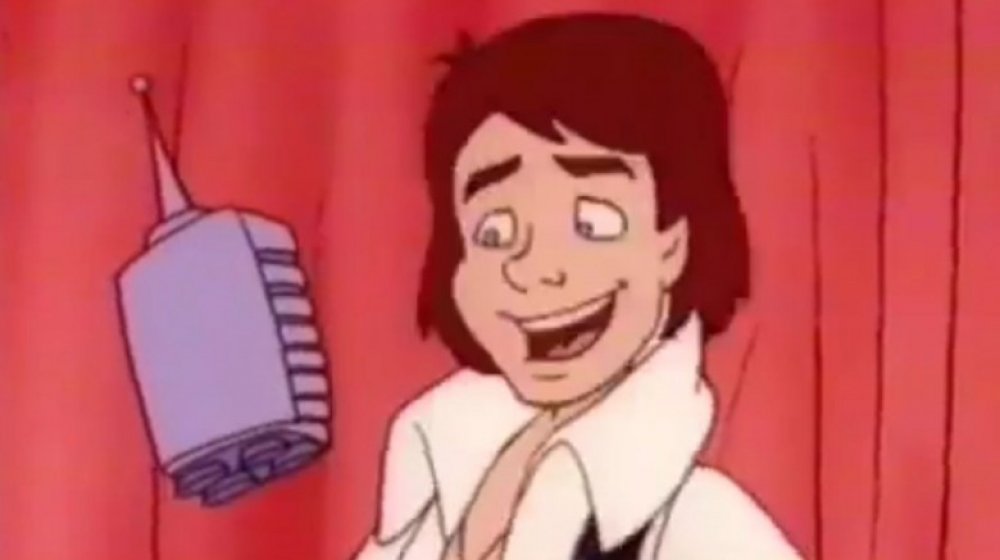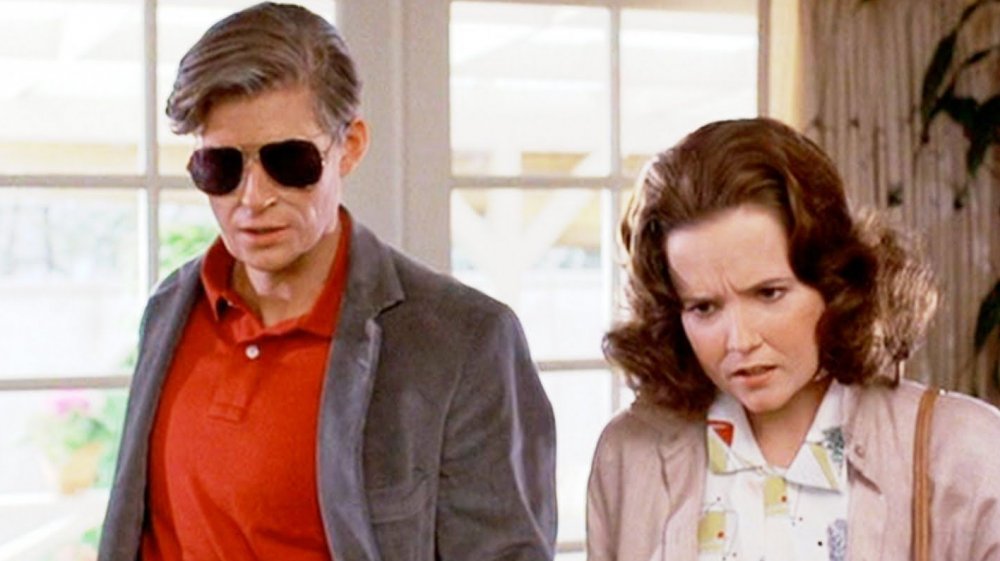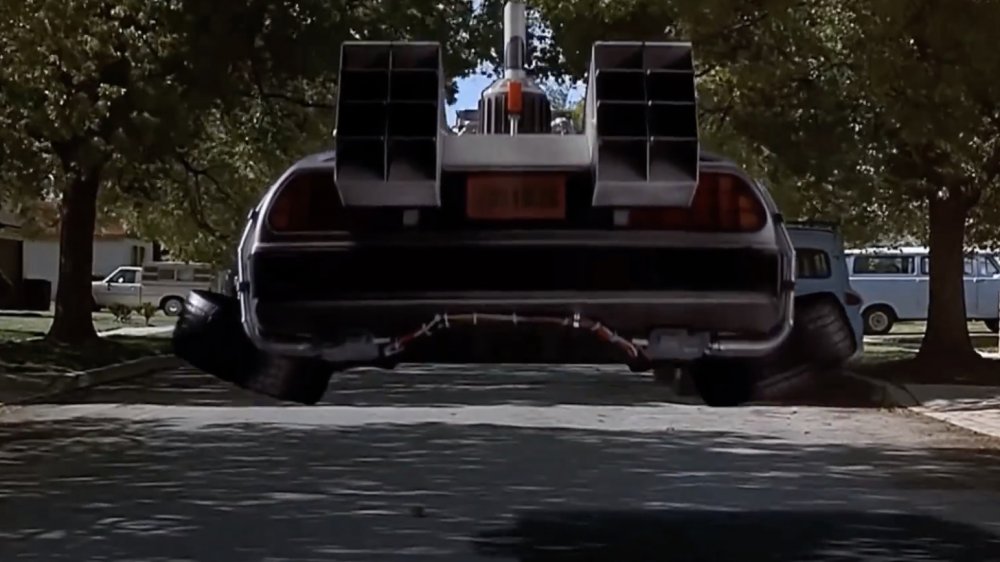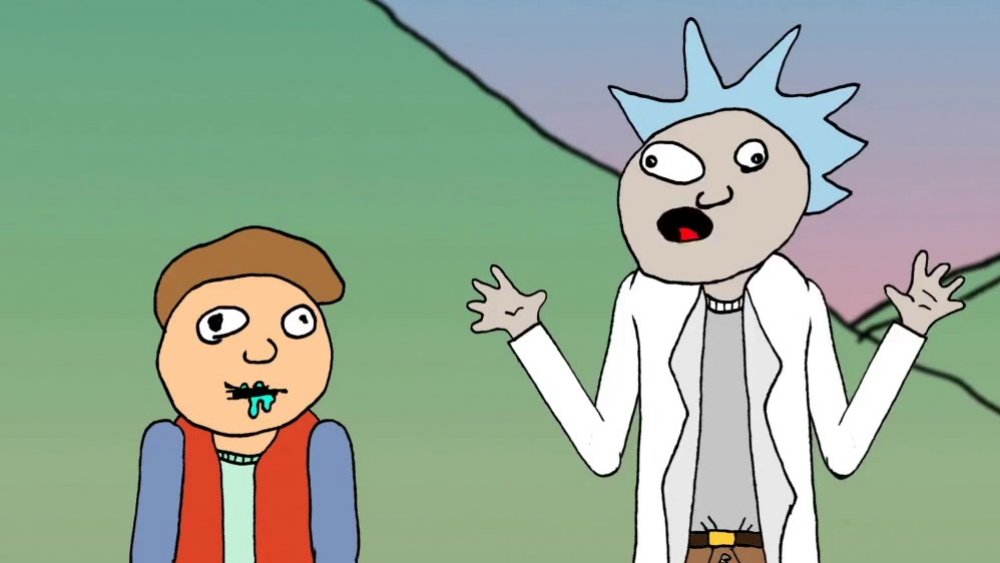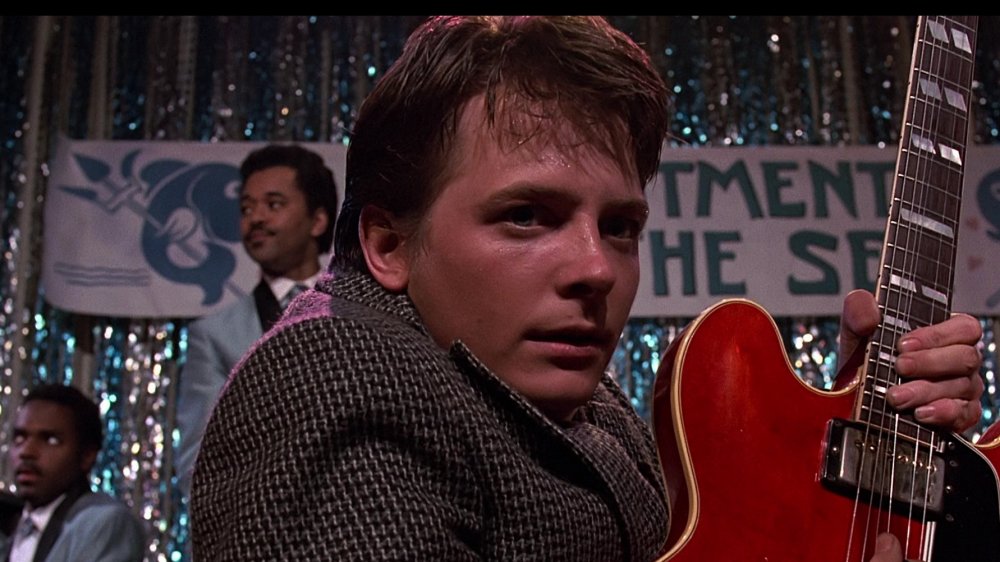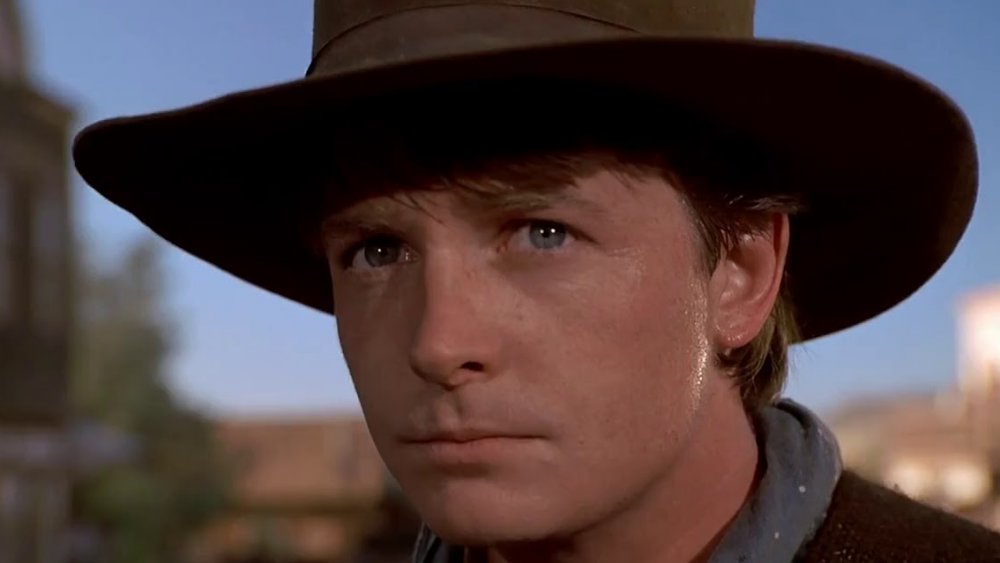The Untold Truth Of Marty McFly
Back to the Future hit theaters in 1985 and instantly became a classic, thanks in so small part to its star, Michael J. Fox. The Emmy-winning Family Ties actor achieved silver screen success in portraying young Marty McFly, a California teen who becomes an unwitting time traveler. He reprised the role in two more madcap adventures in Back to the Future Part II, which takes him to 2015, and Back to the Future Part III, which yanks him into the Old West. Marty McFly handles it all with charm and style, Fox's performance rendering him a rich character with a big backstory and a bright future. As "The Power of Love," the Huey Lewis and the News song written for the 1985 blockbuster, memorably puts it, you don't need money, you don't need fame, you don't need a credit card to ride this train. Hop on board, and explore the little-known details of the life of Marty McFly.
Marty McFly wasn't always so happy-go-lucky
Characters become iconic because they're well-written and performed with panache. Michael J. Fox brought exactly the right amount of charm and mischief to the role of Marty McFly in Back to the Future, making the person created by writer Bob Gale and director Robert Zemeckis feel realistic, relatable, empathetic, and a little impish. Had filmmakers shot the original version of the movie's script, however, a very different Marty would have ended up on screen.
Believe it or not, the first iteration of Back to the Future involved Marty working for Doc Brown, a disgraced physicist who makes a living bootlegging videos. In one early draft of the script, Marty explains that he sweeps out Doc Brown's garage in exchange for $50 a week, free beer, and "total access to his old record collection." Initially, the time machine wasn't a DeLorean, but a laser-based chamber "a bit like a car wash," executive producer Steven Spielberg told Empire. Nevertheless, Marty didn't know it enabled time travel. "He thought it was this thing that was going to shoot off this big electrical discharge," Gale explained, adding that Marty accidentally traveled through time after he climbed into the time machine because he thought it would kill him. "He was so despondent about how messed-up his life was, he was going to commit suicide." Gale said he and Zemeckis stuck with that character trait "for way longer than we should have."
Back to the Future, starring ... Eric Stoltz?
Think of "Marty McFly" and the image of a young Michael J. Fox wearing way too many layers for the California climate or shredding "Johnny B. Goode" at the Enchantment Under the Sea Dance is likely what mentally materializes. The beloved Canadian actor is closely associated with the role of time-traveling teenager Marty McFly, a testament to Back to the Future co-writer and director Robert Zemeckis' good instincts: Fox was his first choice for the part, according to Caseen Gaines' book We Don't Need Roads. It's odd, then, to learn that Fox wasn't actually the first actor to portray Marty McFly in Back to the Future.
At the time of the film's shooting, Fox was starring in NBC's mega-hit sitcom Family Ties, which left little time for anything else in his schedule. So filmmakers went with a pretty good second choice: Eric Stoltz, an up-and-coming young actor best known at the time for his Golden Globe-nominated work in the drama Mask. A few weeks into filming, however, a sinking realization set in for filmmakers: Stoltz was egregiously wrong for the part. That, coupled with Fox's sudden availability, led to Stoltz's dismissal from Back to the Future and the film's production starting over.
BTTF's BFFs: FTW or WTF?
More than 30 years after its release, the most lingering question about Back to the Future remains: How did a teenage boy who only cares about cars, guitars, and girls become best friends with an old and disgraced scientist? It's never quite explained in any of the movies, but franchise co-creator Bob Gale says that it's included in the backstory he and collaborator Robert Zemeckis wrote to inform their script.
"For years, Marty was told that Doc Brown was dangerous, a crackpot, a lunatic. So, being a red-blooded American teenage boy, age 13 or 14, he decided to find out just why this guy was so dangerous," Gale explained to Mental Floss. Marty crept into Doc Brown's personal laboratory and found all sorts of neat scientific stuff and bizarre gadgets. "When Doc found him there, he was delighted to find that Marty thought he was cool and accepted him for what he was. Both of them were black sheep in their respective environments." After that, Doc hired Marty to be his assistant, a job which included everything from keeping the lab tidy to making sure his dog Einstein stayed fed.
Marty met Doc while committing a crime
Back to the Future co-creator Bob Gale never did expand the initial trilogy, but he did co-write a five-issue Back to the Future comic miniseries, released in October 2015 on the very day Marty McFly arrived in what was, circa Back to the Future Part II, the future. Pushing aside his previous explanations and unused screenplay drafts in which the Marty/Doc Brown friendship origin story was explained, Gale took the opportunity to provide another tale of how the time-traveling scientist met the young guitarist.
In the first issue, the action flashes back to 1982. Minor film villain Needles plays with a band called the Tabascos, but the interocitor tube in his guitar amp blows out, leading him to steal one from Marty, which also breaks. Needles steals Marty's guitar, and says he'll only return it if Marty brings him a new interocitor tube. Marty dutifully hits a local music store, but is informed that all of its interocitors have been bought up by local weirdo scientist, Emmett Brown. That prompts Marty to head to Doc Brown's garage and steal what he needs. However, the structure is rigged with a unique security system of traps and puzzles, both of which Marty — much smarter than he gets credit for — navigates with ease. Doc Brown isn't angry at Marty for his attempted burglary — he's so impressed he offers him a job. Thus, their friendship begins.
Marty sure loves Jennifer
At the outset of Back to the Future, Marty cares about little more than his girlfriend, Jennifer Parker. The first movie implies that Marty truly loves her, as a romantic moment is underscored with Huey Lewis and the News' "The Power of Love." George Gipe's Back to the Future novelization reveals that Marty "felt that he 'loved' her in the most adult sense," as Jennifer was "beautiful and fun to be around." Jennifer and Marty are married by the time of the events of Back to the Future Part II, making them that most romantic, all-American cliche: High school sweethearts.
According to the 2016 comic Back to the Future: Untold Tales and Alternate Timelines, Marty and Jennifer first met in the fourth grade, but they weren't particularly close. In November 1984, they reconnect in a one-on-one situation, ruined in part when Marty's rival Needles (played in the movies by Red Hot Chili Peppers bassist Flea) pulls up in his Ford F-150 and asks out Jennifer, despite his girlfriend riding in the truck with him. Marty isn't much better, so distracted by Needles' sweet ride that he doesn't pay much attention to Jennifer, who storms off. The next day, the seeds of their relationship are planted when Jennifer flirts with Marty when she finds him playing Wild Gunman at 7-Eleven and flirtatiously nicknames him "Clint Eastwood."
Marty McFly vs. Principal Strickland
In the days before cheap home video and cable TV, novelizations were the best way to relive a movie. These books were released around a film's debut as a promotional tool, and to meet publishing deadlines, writers worked from early screenplay drafts. As a result, the Back to the Future novelization by George Gipe differs wildly from the movie, offering up significant background detail on music-obsessed Marty McFly.
The story begins with Marty in school, not paying attention to an educational film because he's jamming out to something on his Walkman. He is swiftly embarrassed when he's caught singing along, but is saved when he's summoned to the office for what's purportedly an emergency phone call, but is actually Doc Brown asking him to come to a time machine test at Hill Valley Mall. When Principal Strickland confronts him about the forbidden call, Marty drops his forbidden "Walkman stereo," earning him detention. That's where the administrator makes an example of Marty by destroying the cassette player in a woodworking vice.
Marty ultimately gets the upper hand by setting off a fire alarm so he can sneak off to his band's audition for a YMCA dance across town (not, as depicted in the movie, a tryout in the gym for a school dance). Marty's prank was filmed for Back to the Future but unused, in part because it was one of the few scenes captured with fired original star Eric Stoltz.
The musical Marty McFly
Marty McFly seems to have what it takes to make it as a rock star. He demonstrates his electric guitar chops during an otherwise unsuccessful audition with his band, the Pinheads, early in Back to the Future. Then, near the end of the film, he uses his musical ability to accidentally invent rock and roll, and pass on its major tropes to Chuck Berry, via a phone call from the rock pioneer's cousin, Marvin. And yet, when 2015 rolls around at the start of Back to the Future Part II, Marty is not the world famous rock star he seemed fated to become — he's a broken, overworked office drone pushed around by his boss and hampered by a chronic injury suffered in a long-ago car accident. That setback is undone — and Marty's future presumably rewritten for the better — by the end of Back to the Future Part II, but it's an episode of the forgettable and semi-obscure Back to the Future animated series that shows that Marty's musical dreams came true. The 1991 installment "Solar Sailors" takes place in the year 2091, where Doc encounters a guy who professionally and musically impersonates one of the biggest rock stars of all time: Marty McFly.
Why Marty's parents don't recognize him from their '50s days
Fans of Back to the Future have posited a rather big, unexplained question — or perhaps it's just a massive overlooked plot hole. Why do George and Lorraine McFly fail to recognize the fact that their son, Marty, looks exactly like Calvin Klein, the guy who romantically connected them, blew the roof off their school dance, then disappeared without a trace? Moreover, how do they fail to connect him to the actual Calvin Klein, once that name became world-renowned?
Back to the Future screenwriter Bob Gale offered a reasonable explanation to The Hollywood Reporter in 2020. "George and Lorraine only knew Marty/Calvin for eight days when they were 17," Gale said. "I would ask anyone to think back on their own high school days and ask themselves how well they remember a kid who might have been at their school for even a semester." As for the Calvin Klein stuff, Gale says "Lorraine and George might think it funny." However, Gale and co-writer Robert Zemeckis included a scene in the first three drafts of the Back to the Future script where George McFly sees a photo of Marty in 1955 and figures out his son is a time-traveler. They cut the bit, choosing instead to make Biff the one who realizes Marty can travel through time.
Marty McFly invented the flying car
Doc Brown's DeLorean is already a pretty cool car, what with its gull-wing doors and ability to travel through time. But the sequel-teasing final moments of the first Back to the Future show that Doc has made some improvements to the vehicle, necessary for a trip to 2015. "Where we're going we don't need roads," he quips to Marty, then sets the DeLorean to flying car mode as it launches into the sky above Hill Valley.
In the 2016 comic book Back to the Future #4, it's made clear that Doc Brown turned his car into a marvelous flying machine upon the suggestion of Marty McFly. Set in a period before the events of the first film, Marty disturbs Doc in his garage, who covers up his not-quite-ready-for-showtime DeLorean. Marty, without a car and desperately in want of one, recognizes the shape, and presumes that Doc's top secret project is a flying car. It's not, but Doc Brown thinks that such a project is a pretty good idea.
How Doc and Marty became Rick and Morty
Back in the early 2000s, animator Justin Roiland made a truly obscene cartoon short called "The Real Animated Adventures of Doc and Mharti." The former is a wild-haired, lab-coat wearing scientist with a DeLorean-esque time machine who speaks in an approximate imitation of Christopher Lloyd, while the latter is a kid in an orange puffy vest with a high-pitched squeak of a voice. In other words, they are clear parodies of Doc Brown and Marty McFly, with little more than a misspelled name keeping them from incurring the wrath of the copyright holders.
Roiland screened this cartoon and others at Channel 101, a regular short film showcase and competition in Los Angeles operated by Community creator Dan Harmon. After Harmon was temporarily relieved of his duties at that NBC sitcom, he asked Roiland to adapt Doc and Mharti into a regular, more professionally animated series that ditched the more overt Back to the Future connections. So, Doc became a scientist named Rick, and it was a short leap from Mharti to Morty, who became the scientist's grandson, not friend. Thus, Rick and Morty was born.
So many Marty McFlys
In addition to portraying Marty McFly (and other members of the McFly family) in Back to the Future, Back to the Future Part II, and Back to the Future Part III, Michael J. Fox reprised his best-known role in the Lego Dimensions video game and in Back to the Future: The Game, albeit as Marty Future. But Michael J. Fox isn't the only actor to ever portray Marty McFly in a finished production.
Fox didn't do his own singing during the iconic "Johnny B. Goode" sequence — that was handled by Mark Campbell, a real-life rock frontman. For the film series' many non-live-action offshoots and spinoffs, Fox left the acting to established voice actors. In Back to the Future: The Game, the primary version of Marty McFly is portrayed by A.J. LoCasio, who also lent his voice to a couple of Back to the Future-themed talking pinball machines. The guy who sounds nearly identical to Fox on the 1990s Back to the Future Saturday morning cartoon is a voice actor named David Kaufman, who can perform such a great impression of Fox that he also took over for Fox when his 1998 movie Stuart Little was adapted into an animated series.
Hello, McFly
In Back to the Future, Marty McFly travels back in time to 1955, which just so happens to be the year of the release of Marty, a film that won the 1956 Academy Award for Best Picture. Screenwriters Bob Gale and Robert Zemeckis claim that this is all a coincidence, and that they named Marty not after a '50s movie, but a real person. "We knew a guy named Marty who was a production assistant on Used Cars," Gale told Box Office Mojo in 2003. Both filmmakers worked on that 1980 film, and they're referring to crew member Marty Casella, who curiously was not among the Back to the Future staff. As for the last name of McFly, it simply presented itself. "Zemeckis just said, 'How about McFly?'" Gale recalled.
While that's a real, if obscure and rarely used last name, Gale likely knew it from a movie. The 1967 film The Honey Pot starred Cliff Robertson as a character named William McFly, which Back to the Future Part III reveals is also the name of Marty McFly's great-grandfather.
